Back to list
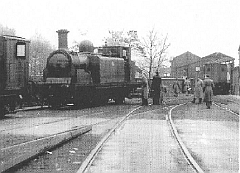
Whittingham Hospital Railway Sentinel GRADWELL and O-4-2T JAMES FRYER in Whittingham yard. The 0-4-2T was ex LB&SCR Class D1 No.357.
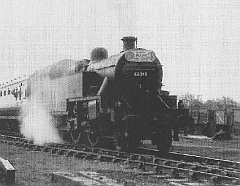
Bottom Right 42316 at Pilling.
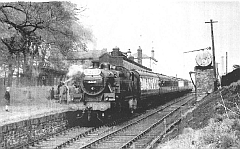
42316 at the platform of the closed Longridge station
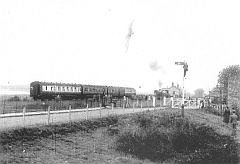
Glasson Dock where the tour train was divided for reversal. Note the coaching stock which includes the Midland clerestory and the LNWR
Club saloon.
Original Acknowlegements
Thanks are due to Peter Bingham for supplying "Descriptive Notes on the Route" which were issued to all participants and on which much of this article has been based. Also for the "BR Special Notice"
Thanks also to Neville Fields who reprinted the four photographs from 1954 negatives, and to John Tate for arranging for them to be reproduced. Reference has also been made to the records of the late Harold Bowtell.
This article first appeared in the MLS journal The Mancunian, Issue 240 (2004), available online to MLS members.
THE SLS/MLS RAILTOURS
7. The North Lancashire Railtour, 1st May 1954
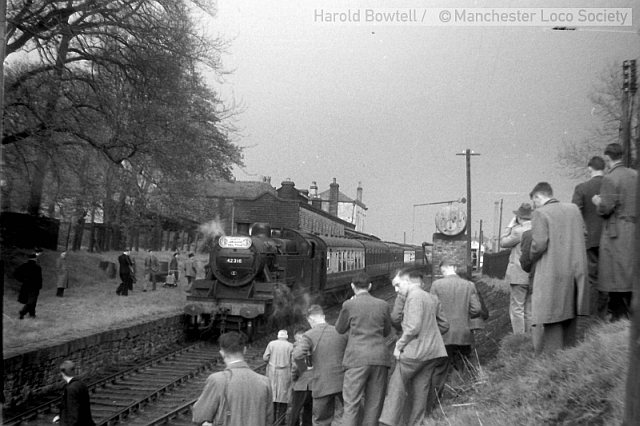
On 1st May 1954, in extremely bad weather conditions, the Manchester Locomotive Society ran this tour from Preston in conjunction with the SLS (North West Area). The train was worked throughout by 2-6-4T 42316 of Crewe North shed with six of the LMS "luxury" club saloons plus a brake third open, and carried a full load of 228 passengers. Forty other applicants were disappointed as the accommodation was sold out. Departure from Preston was scheduled for 2.10pm when the station was unusually quiet because it was F.A.Cup Final Day at Wembley and Preston North End were playing West Bromwich Albion. Albion won the Cup 3-2.
In the morning some members went by bus from Preston to Grimsargh to go to the Whittingham Mental Hospital Light Railway. The hospital opened in 1873 and the 1¾ mile line through pastoral countryside from Grimsargh station to the hospital opened 6 years later. There were morning and evening trains for the staff at the hospital plus additional trains on Saturday afternoons for the benefit of visitors who were carried free of charge. A freight train also ran as required. The line had two locomotives. No.1 was a O-4-2T named JAMES FRYARS which was an ex LB&SCR Class D1 No.357 (later SR 2357); it was named RIDDLESDOWN and was obtained from Ashford Works in February 1947. The other loco was a vertical boiler "Sentinel" O-4-0 GRADWELL, built at Shrewsbury in 1947 (works no.9377) and obtained from Bolton Gas Department in 1953.
The tour train left Preston on time for Longridge (7¼ miles) with the engine running bunker first but there were difficulties in operating so lengthy a train on the branches which were to be covered which proved too much for the timetable. This was to result in a very late arrival back in Preston at the end of the tour.
The line to Longridge opened as long ago as 1890 as a horse worked tramway but in 1846 it was taken over by the Fleetwood, Preston & West Riding Junction Railway with the intention of extending through to Skipton but this never happened. Passenger traffic began in 1856 from a small platform at Maudlands (Preston) but in 1867 the line was absorbed jointly by the L&YR and L&NWR with passenger trains from Longridge eventually getting into Preston station in 1885. Passenger services were withdrawn on 31 May 1930 when the last train from Longridge was hauled by 2-4-2T 10606 which was adorned with a wreath to mark the occasion. At that time there were 9(SX) and 10(SO) trains each way, but at the time of the tour freight still operated to the terminus.
On the tour, the 2-6-4T was slipping almost incessantly up to Longridge and nearly stalled at one point but when it finally reached Longridge station the loco took water, reversed and was swarmed by photographers (see picture above), despite the weather, and this was the first of such occasions during the day. Returning from Longridge the train passed through platform 10 on the East Lancashire side of Preston station to Todd Lane Junction, Lostock Hall Junction and Farington Curve Junction to pass through Preston station again in the northbound direction. This routing was commonplace for trains from the north heading for the Fylde Coast, and also for trains in the reverse direction from Blackpool and Fleetwood. On this circuit of Preston there was a special stop to pick up a passenger who had left Manchester in the morning but found himself in St.Annes on Sea.
Also on this circuit the train passed under the cliff on which the one time L&YR / L&NWR Park Hotel, later the County Hall annexe, stood, and also Lostock Hall shed. From Preston we took the main line to Garstang & Catterall station where we used the outer face of the short down island platform to join the Knott End line. This single line continued for about a mile alongside the WCML before turning westwards. On the right could be seen the remains of the former Garstang & Knott End loco shed before entering Garstang Town.
The level crossing gates had to be opened and closed using a key contained in the train's single line staff and this operation by the train crew took place six times before we were back on the main line. It was a lengthy operation. Because of this, and the fact that speed was limited to 15/25 mph, progress was very slow and this did not help timekeeping. After passing the sites of the closed stations at Nateby, Cockerham Cross Halt and Garstang Road Halt, the train finally reached Pilling, about 7 miles from Garstang & Catterall. This was the end of the line which was worked on the "one engine in steam" system for freight, the 4½ mile section on to Knott End having been abandoned in November 1950.
At Pilling a lot of residents had turned out in the rain to see the train, complete with flags and bunting. Most of the passengers also disembarked and apart from taking more photographs, watched the complicated manoeuvre to reverse the train which was the longest ever to be used on the branch. The problem was the shortness of the passing loop which meant the train had to be uncoupled and split into two parts before the loco could run round. So the 22 minutes allowed in the timetable was not nearly enough and it actually took 40 minutes; thus, departure was 36 minutes late.
On the return from Pilling there was an amusing incident when the train stopped at one of the gated crossings. A herd of Friesian cattle was grazing in an adjoining field and they galloped up to the hedge, then with bovine curiosity surveyed the passengers. Back at Garstang, the train reversed again in the Knott End loop and the loco ran round. This loop was originally a siding but as a wartime measure a junction was laid in with the main line in 1942 and it was by this means that 42316 ran round.
The tour train was 47 minutes late when it set off for Lancaster and the Glasson Dock branch. This branch was not opened until 1883 although the dock had opened nearly 100 years earlier in 1787; this delay was mainly due to the opposition of the powerful Lancaster Canal Co. which had built a canal to the dock in 1826. In 1888 there were four daily passenger trains in each direction on the branch and when services were withdrawn from 7 July 1930 there were still four trains. At the time of the tour it was still used for freight, trains usually being worked by Class 4F O-6-0s.
A large crowd was waiting on the derelict platform at Glasson to the arrival of the train, including several youngsters. Some of them climbed signal ladders and many of them put pennies on the rails for the passing train to flatten them as souvenirs. At one time there was a private platform on the branch which in old days was used by the late Lord Ashton when he was in residence at Ashton Hall. The remains of this platform could be seen from the train whilst the hall became the Club House of the Lancaster Golf Club. The rain had eased somewhat at Glasson and again most passengers disembarked to watch the train being divided once again so that the loco could run round. A mere 24 minutes had been allowed for this.
Reversal was again necessary when we got back to Lancaster so we could go north to Arnside, but by now we had lost so much time and were so late that passengers were told that arrangements had been made for anyone for Manchester who wanted to be home by midnight to leave the train at Lancaster. Some did so, along with some who had long distances to travel, but many decided to stay on the train and complete the tour which then headed for Arnside and yet another reversal to get on to the line to Hincaster Junction.
This had been authorised in 1865 but construction was delayed because the promoting company was dissolved and powers transferred to the Furness Railway. It opened on 26 June 1876, following which the Furness got running powers to Kendal and Tebay. The line was about 5¼ miles in length, single throughout with intermediate stations at Sandside and Heversham and in 1922 there were five trains each way between Kendal and Grange over Sands. The passenger service was suspended in 1942 when there were three trains and the withdrawal was made permanent in 1953.
However, a fortnightly train for convalescing Durham miners continued and in the summer there was an unadvertised Windermere to Leeds train which ran this way. However, at the time of the tour there was still a large amount of freight traffic, mainly coke from Durham to Barrow in Furness which came by the Barnard Castle to Tebay line. The tour continued north to Oxenholme to reverse again and return to Lancaster to cover the last branch on the schedule, which was to Lancaster Old.
However, it was becoming increasingly likely that because of the late running, this part would be abandoned. And this part was also marred by the increasing likelihood of passengers missing their last trains at Preston. However, just before 10.00pm and by now around 90 minutes late, the train began to back for 490 yards into Lancaster Old station. There were 41 members of the Lancaster Branch of the Historical Association on the train and this was one of the "highlights" for them. On arrival it was too dark to inspect the old station or to see traces of its former glory when it was the northern terminal of the railway system in the 1840s. But flash bulbs flared in the rainy darkness and it was suggested that these were the first civilian passengers to arrive and alight here since 1849!
Departure from Lancaster (Old Station) was at 10.19pm but the train was held at Lancaster No.1 signal box for about 15 minutes to allow the Up "West Coast Postal" and a following train to go through. As a result, the tour finally got back into Preston at about 11.15pm, over 2 hours late. It is not known how and when many of the passengers eventually got home but there were some late night trains from Preston at 11.25pm to Accrington, 11.30pm to Manchester Victoria, 11.35pm to Blackpool and 11.40pm to Liverpool Exchange.
The driver of 42316 was W.Threlfall, his Fireman was R.Brown and the guard was R.Doddington, all from Preston. The train was accompanied throughout by Traffic Inspector F.S.Baker whilst the Preston Assistant Station Master travelled with the train on the Longridge line. Some of the passengers had come long distances to take part in the trip, including people from Rye and Hastings in Sussex, Leven in Fife, Newcastle on Tyne and Anglesey, whilst there were several from the Birmingham and London areas plus, of course, the large contingents from Manchester and Lancaster.
Mr.Wetherby of The Manchester Guardian travelled on the train and wrote a lengthy report whilst other newspapers to report the tour were The Lancaster Guardian and Observer (on 7/5/54) and The Visitor (Morecambe) (on 12/5/54).
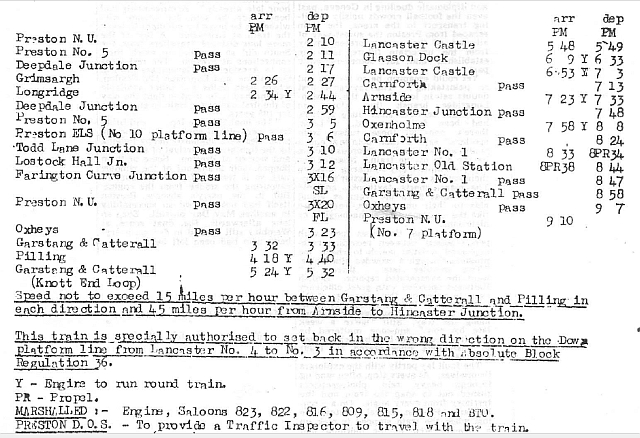
The Locomotive: 42316
This 2-6-4T was one of the earliest of the class, being built at Derby as 2316 and entering traffic on 14 March 1928, allocated to Longsight shed. Just over 3 months later, 30/6/28, it was transferred to Stafford and subsequently it worked from the following sheds:—
28/ 7/28 Swansea; 21/12/41 Stoke; 19/10/57 Willesden; 19/4/58 Willesden; 31/10/28 Shrewsbury; 19/1/46 Willesden ; 8/ 2/58 Longsight; 5/7/58 Stockport ; 11/11/33 Preston; 30/ 1/54 Crewe North; 15/ 2/58 Willesden; 3/10/36 Stockport; 14/ 4/56 Northampton; 22/3/58 Neasden.
The loco was renumbered as BR 42316 in November 1948 and withdrawn in February 1963 after nearly 35 years in service.
The Coaching Stock
The composition of the train was listed in the BR official notice and comprised saloons 823, 822, 816, 809, 815, 818 and a brake third open coach.Brief details are:
823 A club-car built in 1939 for the "Coronation Scot" set which was shipped to the USA in that year. Following the outbreak of war, it spent some years in Florida as Officers Mess accommodation for the US Army Air Force.
822 A specially designed 60ft saloon built in 1935 for the Blackpool—Manchester(Vic) "Club Train". Inside were three separate saloons, each equipped with individual arm chairs and tables, and an attendants compartment
815 One of the coaches built in 1908/09 for the LNWR "American Special" services, three in 1908/09 and another six in 1913. After the war they became LMS 10021~29 and this one became a club saloon on the "Llandudno—Manchester Exchange Club Train".
816 This was another "American Special" car built in 1913 and became Club Car No.1 on the "Llandudno Club Train". These two cars became LMS 10023/28 in which seating was in four seat and five seat saloons with individual armchairs/settees.
809 This was a Midland Clerestory built 1909, known as a "Semi Royal" and used by members of the Royal Family. It is believed to have been built originally for use by the Queen (Queen Mary from 1910).
818 A 1925 LMS built car, possibly for the ”Southport Club Train". No more information. when first planned it was intended that the tour train would consist of five vehicles (the first four plus the BTO) but because of the high demand for tickets, two additional coaches were added.
Last update December 2023. Comments welcome: website@manlocosoc.co.uk